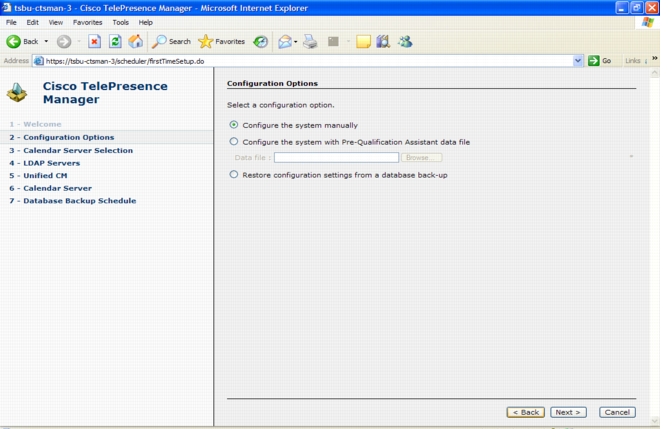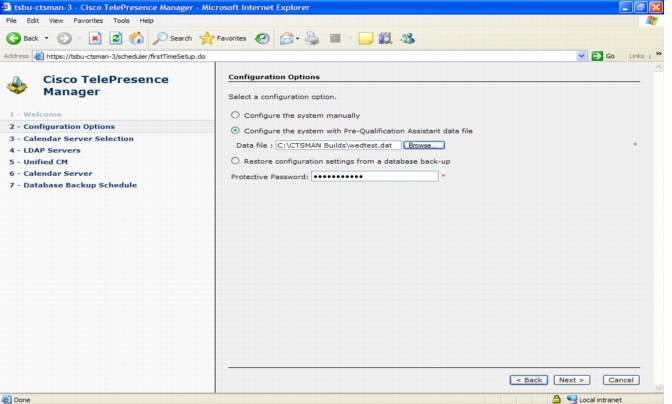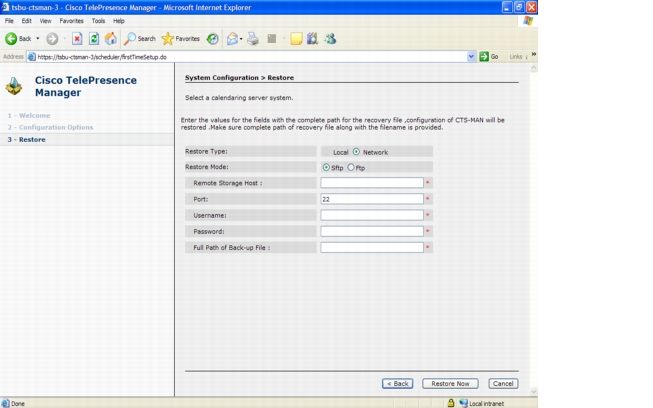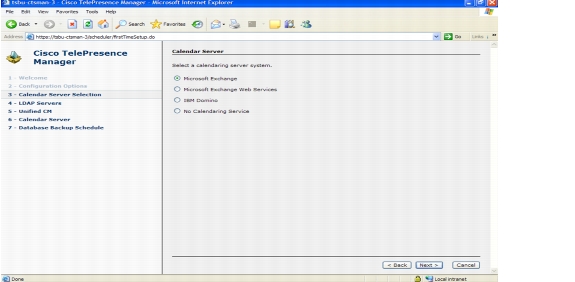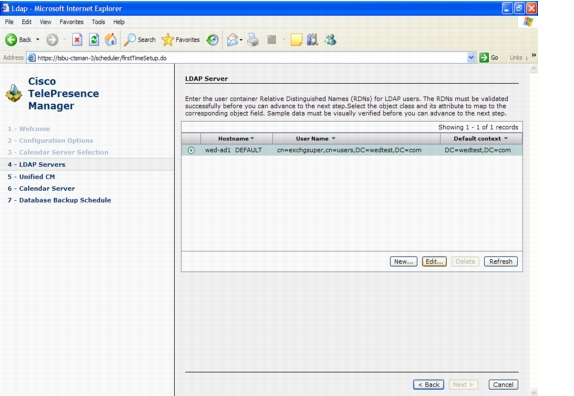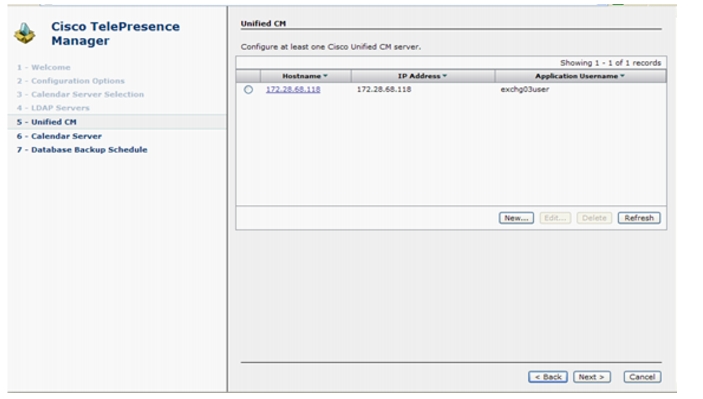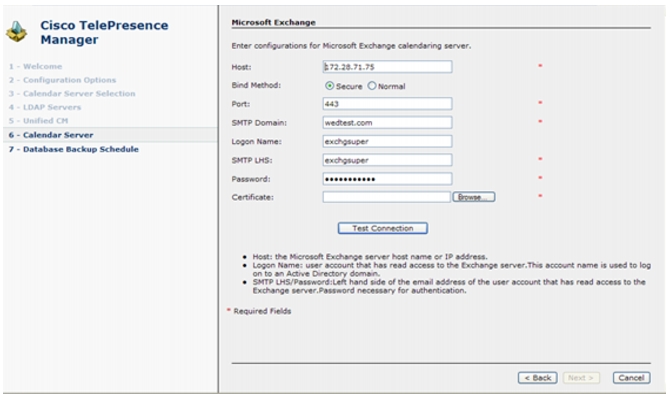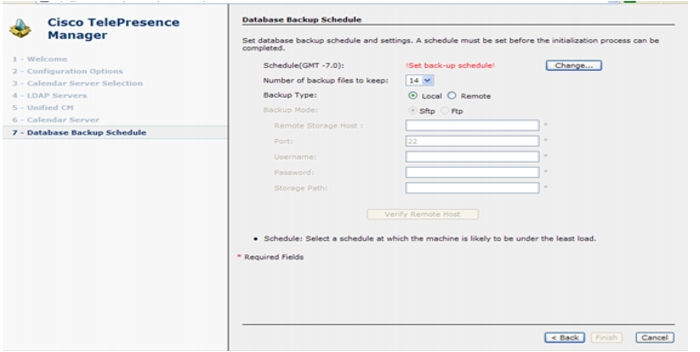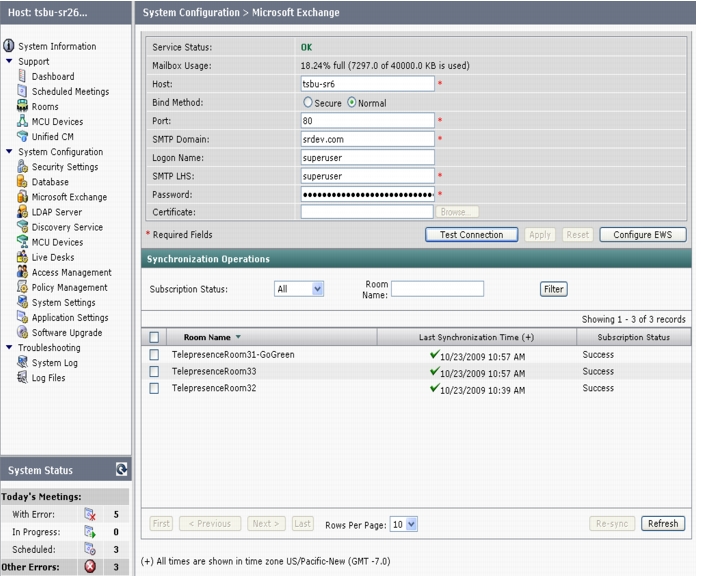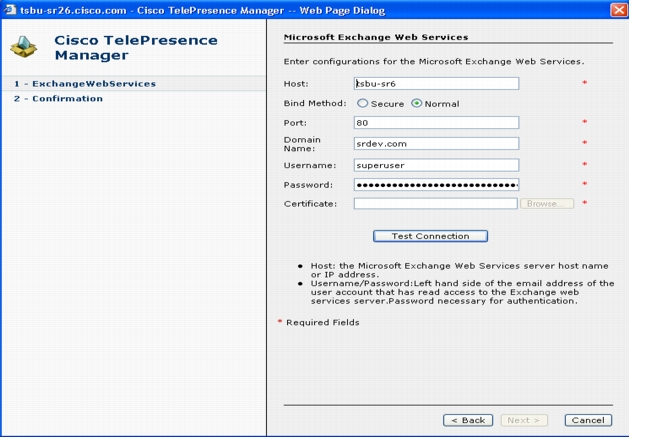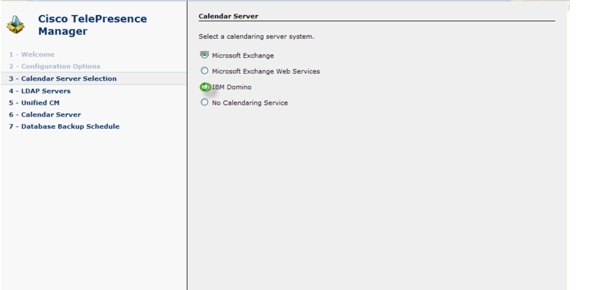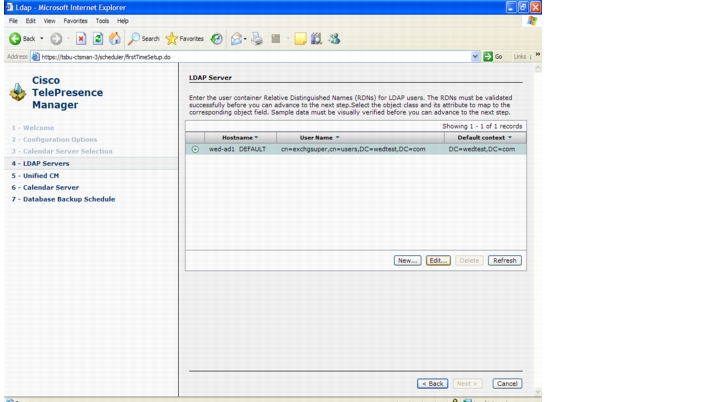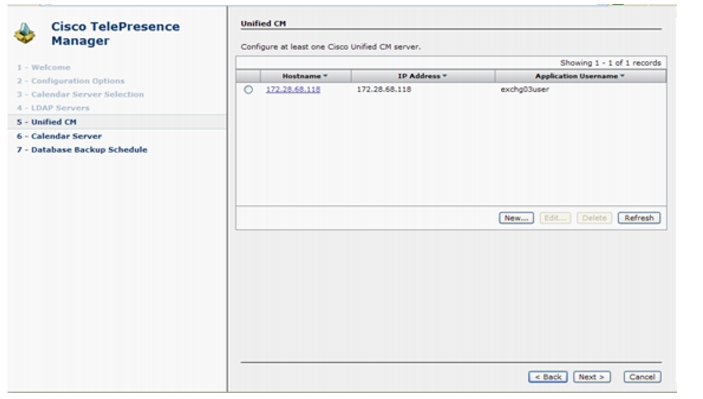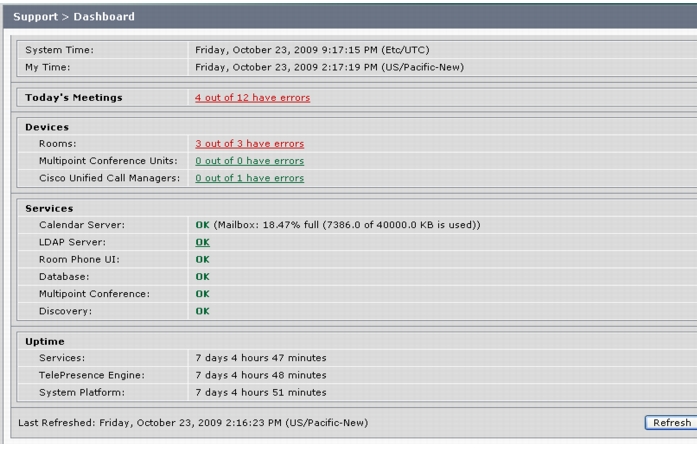

-
Cisco TelePresence Manager 1.6 Administration and Installation Guide
-
Preface
-
End User License Agreement
-
General Information About the Cisco TelePresence Manager
-
Pre-Install System Setup for Cisco TelePresence Manager
-
Configuring Microsoft Exchange for Cisco TelePresence Manager
-
Configuring IBM Domino Server for Cisco TelePresence Manager
-
Configuring Cisco Unified CM for Cisco TelePresence Manager
-
Installing and Configuring Cisco PreQualification Assistant
-
Installing or Upgrading Cisco TelePresence Manager
-
Initializing Cisco TelePresence Manager
-
Additional Installation Configurations for Cisco TelePresence Manager
-
Monitoring Cisco TelePresence Manager
-
CTS-MAN Emails and End-User Web UI
-
Supported MIBs for Cisco TelePresence Manager
-
Troubleshooting Cisco TelePresence Manager
-
Table Of Contents
Initializing Cisco TelePresence Manager
Post-Install Guidelines for CTS-Manager
Initializing Cisco TelePresence Manager After Installation
Required Information and Equipment
Initialization for Microsoft Exchange Deployments
CTS-Manager Configuration Options
Configure the system with Pre-Qualification Assistant Data File
Restore Configuration Settings from a Database Backup
Verifying the LDAP Servers Configuration
Cisco Unified Call Manager (CUCM) Server Configuration
Verifying the Cisco Unified Communications Manager Configuration
Explanation of Microsoft Exchange Fields
Explanation of Database Backup Schedule Fields
Microsoft Exchange Calendar Service Window
Initialization for IBM Domino Deployments
Verifying the LDAP Servers Configuration
Cisco Unified Call Manager (CUCM) Server Configuration
Verifying the Cisco Unified Communications Manager Configuration
Explanation of IBM Domino Fields
Dashboard for Verification of Installation Status
Initializing Cisco TelePresence Manager
Revised: April 20, 2010, OL-13673-06
First Published: November 27, 2006Contents
•
Post-Install Guidelines for CTS-Manager, page 8-2
•
Initializing Cisco TelePresence Manager After Installation, page 8-3
•
Required Information and Equipment, page 8-3
•
Initialization for Microsoft Exchange Deployments, page 8-4
•
CTS-Manager Configuration Options, page 8-4
•
Configure the system with Pre-Qualification Assistant Data File, page 8-6
•
Restore Configuration Settings from a Database Backup, page 8-6
•
Calendar Server Option, page 8-7
•
Verifying the LDAP Servers Configuration, page 8-8
•
Cisco Unified Call Manager (CUCM) Server Configuration, page 8-10
•
Verifying the Cisco Unified Communications Manager Configuration, page 8-10
•
Calendar Server Configuration, page 8-11
•
Explanation of Microsoft Exchange Fields, page 8-11
•
Database Backup Schedule, page 8-12
•
Microsoft Exchange Calendar Service Window, page 8-14
•
Re-sync Operations, page 8-17
•
Initialization for IBM Domino Deployments, page 8-18
•
Verifying the LDAP Servers Configuration, page 8-19
•
Cisco Unified Call Manager (CUCM) Server Configuration, page 8-21
•
IBM Domino Calendar, page 8-23
•
Explanation of IBM Domino Fields, page 8-23
•
Dashboard for Verification of Installation Status, page 8-24
Introduction
After installing the Cisco TelePresence Manager, the next step is to initialize the program.
The next process is initializing Cisco TelePresence Manager to enable access to information sources such as Microsoft Exchange Server for meeting requests from Microsoft Outlook, Active Directory for accessing user and conference room information, and Cisco Unified Communications Manager for conference room availability and telephone support.
The tasks for initializing the Cisco TelePresence Manager are described in the following sections.
Post-Install Guidelines for CTS-Manager
The purpose of this guide is to outline the information you will need to reference in order to initialize the CTS-Manager system after installing the CTS-Manager.
The flow of tasks you need to do for additional configurations the CTS-Manager are provided in the following table.
Table 8-1 Post-Install Procedure Guidelines for setting up CTS-Manager
If at any time you encounter problems, go to Chapter 13, Troubleshooting Cisco TelePresence Manager to see how to correct the problem.
Initializing Cisco TelePresence Manager After Installation
This section contains the following topics pertaining to initialization:
•
Required Information and Equipment, page 8-3
•
Initialization Procedure, page 8-4
To initialize Cisco TelePresence Manager, you must enter contact and access information for your Microsoft Exchange Server, Lightweight Directory Access Protocol (LDAP) server, and Cisco Unified CM in a series of one-time-only, post-installation initialization windows.
Required Information and Equipment
To set up and initialize Cisco TelePresence Manager, you need the information previously entered or created during pre-installation.
Additionally, Cisco TelePresence Manager must have network access to a computer running Windows Explorer version 6.1.3, Microsoft Exchange Server and Active Directory, (set to level 2) server, Microsoft EWS server, or IBM Domino Server and Domino Directory Server, and Cisco Unified Communications Manager.
Initialization Procedure
The system administrator can access and change the information after initialization from the Configuration tab of the Cisco TelePresence Manager web interface.
Initialization for Microsoft Exchange Deployments
Step 1
At the console running Microsoft Explorer, type the Cisco TelePresence Manager server name or the IP address. See the following example.
https://server hostname or IP addressStep 2
The Initial Preferences window is displayed. Choose the timezone from the drop-down menu. The timezone you choose should be the one you are located in. Click Continue.
Figure 8-1 Initial Preferences Window
Step 3
At the product page that appears, click on Cisco TelePresence Manager.
Step 4
At the login page, enter the username and password created during installation.
The Cisco TelePresence Manager initial window appears with several fields already populated from the installation process.
CTS-Manager Configuration Options
The initial window to open is the Configuration Options window. This window allows you to configure the system manually or to restore the configuration settings from a database back-up.
Figure 8-2 Configuration Options Window
This windows offers three options for configuring your CTS-Manager:
•
Configure the system manually
•
Configure the system with the Pre-Qualification Assistant data
•
Restore configuration settings from a database back-up.
Configure the System Manually
This option allows you to set up your configurations for a First Time Setup. You are not able to do a restore or use the Pre-Qualification data files.
You will have to add the server information in all the screens.
Configure the system with Pre-Qualification Assistant Data File
If selecting the FTS using the Pre-Qualification data, this option allows you to select the data file that you have previously set up. Refer to Chapter 6, "Installing and Configuring Cisco PreQualification Assistant"
Figure 8-3 FTS Configuration Option - Pre-Qualification
Step 1
Use the Browse button to find the location of the data file and select it.
Step 2
Put in your admin or superuser password.
Step 3
Click Next.
Note
If this option is selected, it is necessary to test the LDAP servers connections through the Pre-Qualification Assistant tool.
Restore Configuration Settings from a Database Backup
If selecting the FTS using the restore option, this option allows you to select the data that you have previously backed up. Refer to Chapter 9, "Additional Installation Configurations for Cisco TelePresence Manager", section, Database - Status, Backup, and Restore for further details on backing up your system database.
Step 1
Select the Restore configuration settings from a database back-up option. Click on the Next button.
Step 2
The System Configuration>Restore window appears. This window is where you need to fill in the fields of the path of the recovery file and the file name.
Figure 8-4 FTS Configuration - Restore Window
Step 3
After filling in the details, click the Restore Now button. The backup data will be restored to the CTS-Manager system.
After selecting the configuration option and setting up the data, the next step is to set up the Calendar server option.
Calendar Server Option
The Calendar Server Selection allows you to select the calendaring server for your system. The options are:
•
Microsoft Exchange
•
Microsoft Exchange Web Services (EWS)
•
IBM Domino
•
No Calendering Service
Step 1
The Calendar Server Selection window is displayed. See Figure 8-5.
Choose Microsoft Exchange for this deployment and click Next.
Figure 8-5 Calendar Server Selection Window
Step 2
Click Next.
Step 3
The LDAP Servers window opens. See Figure 8-6.
Verifying the LDAP Servers Configuration
Lightweight Directory Access Protocol (LDAP) is a protocol definition for accessing directories. This window provides you with the records of the LDAP servers that have been set up. To add new ones or to edit the one listed, select the record that is listed, then click either the New or Edit button. For more information about setting up servers, refer to Chapter 9, "Additional Installation Configurations for Cisco TelePresence Manager"
If you have selected the Configure the system with Pre-Qualification Assistant data file option, you must select the server record and click on Edit. The next window that appears gives you the setup information, you must test the connection. You have to do this with all the LDAP servers that you have configured before you can select the Next button.
In the LDAP server window example Figure 8-6, it shows one record.
Figure 8-6 LDAP Servers Window
Note
Step 1
Select the first listed record, then click on Edit. Or, if adding a new one click New.
Step 2
When the popup window LDAP Server Settings appears, make sure the information is correct. For further information, refer to Chapter 9, Settings for LDAP. If necessary, make changes in the fields. If this is a new server, put in the information in all the fields.
Click on Test Connection button.
•
The system tests the connection information. A popup window opens and displays the message "Connection to <....> Server was Verified." Click OK, then click Next.
Step 3
The LDAP Server window re-appears. If you have more records to test, repeat Step 1 through Step 3.
Step 4
If all the server settings have been tested, click the Next button.
Note
Microsoft Exchange WebDAV and EWS environments: CTS-Manager 1.6.2 and earlier support only one LDAP server. 1.6.3 and later support unlimited LDAP servers.
Cisco Unified Call Manager (CUCM) Server Configuration
This window allows you to review the CUCM server(s) that was configured and verify the setup through the Pre-Qualification Assistant.
Figure 8-7 Cisco Unified CM Configuration Window
Verifying the Cisco Unified Communications Manager Configuration
Step 1
Select the first listed record, then click on Edit. Or, if adding a new one, click New.
Step 2
When the popup window CUCM Server Settings appears, make sure the information is correct. For further information, refer to Chapter 9, Settings for CUCM. If necessary, make changes in this window.
•
Click on Test Connection button. The system tests the connection information. A popup window opens and displays the message "Connection to <....> Server was Verified." Click OK, then click Next.
Step 3
The CUCM Server window re-appears. If you have more records to test, repeat Step 1 through Step 3.
Step 4
If all the server settings have been tested, click the Next button.
Note
If the system cannot verify the connection, the popup window directs the user to re-enter the information.
Calendar Server Configuration
This window allows you to configure the Calendar server that was configured and verify the setup. This example covers a Microsoft Exchange calendaring server. For further information about Calendar server configurations, refer to Chapter 9, "Additional Installation Configurations for Cisco TelePresence Manager".
Figure 8-8 Calendar Server Configuration Window
Explanation of Microsoft Exchange Fields
•
Host
Host is the hostname or IP address of the Microsoft Exchange Server host.
•
Bind Method
The bind method indicates the desired level of security.
–
Secure—Secure Socket Layer (SSL) connection requires the Distinguished Encoding Rules (DER) Certificate for the Microsoft Exchange Server. You must complete the Certificate field on this window before you can proceed.
–
Normal—The Cisco TelePresence Manager communicates with the Microsoft Exchange Server in cleartext using HTTP.
•
Port
The default value is 80, for secure mode the value is 443.
•
SMTP Domain Name
This field requires a sequence of case-insensitive ASCII labels separated by dots (for example, "cisco.com")—defined for subtrees in the Internet Domain Name System and used in other Internet identifiers, such as hostnames, mailbox names, and URLs.
•
Logon Name
The logon username should have read access to the Exchange server and rooms. This account name is used to logon to an Active Directory domain.
•
SMTP LHS
Left hand side of the email address of the user account that has read access to the Exchange Server. Password is necessary for authentication.
•
Password
The user password allows access to the Microsoft Exchange Server.
•
Certificate
A certificate is a digital representation of user or device attributes, including a public key, that is signed with an authoritative private key. In a self-signature, the signature can be verified using the public key contained in the certificate.
Note
Click the Browse... button to choose the Microsoft Exchange Server SSL certificate.
If you selected Secure bind method, this value is required.Click on the Test Connection button to verify this configuration. When the verification is completed, click on the Next button.
Database Backup Schedule
The Database Backup Schedule window opens. See Figure 8-9.
Fill in the fields. If you are setting up a remote backup, click Verify Remote Host to verify the login information. For additional information about Database Backup, refer to Chapter 9, "Additional Installation Configurations for Cisco TelePresence Manager", Database - Status, Backup, and Restore section.
Note
The default is set to a daily backup schedule with the backup information stored to the local drive. Cisco recommends that you back up your data to a different drive.
Figure 8-9 Database Backup Schedule Window
Explanation of Database Backup Schedule Fields
The Cisco Unified Communications Manager uses an Informix Database server to store information. This window allows the administrator to set up regular backup operations of the database.
Note
Cisco strongly recommends scheduling regular backups of the database.
The Database Backup Schedule window contains the following fields:
•
Schedule
Click Change... to set the backup schedule. The following choices are available:
–
Start Time (UTC)
Enter the hour and minute, in UTC 24-hour format, for when you want your backup to begin. UTC is the atomic clock version of Universal Time (UT), formerly known as Greenwich Mean Time. Time zones around the world are expressed as positive and negative offsets from UT. For example, Midnight Pacific Standard Time (+8 UT) is 08:00 UT.
–
Frequency
Choose Daily or Weekly database backups. If you choose Weekly, select the radio button beside the day of the week on which you want your backup to occur.
•
Number of backup files to keep
From the drop-down menu, choose the number of backup files to keep before deleting. Choices range from 1 (default) to 14 (two week's worth of daily backups).
•
Backup Type
Choose Local or Remote to designate the server for backups. If you select Local, the backup files are stored on your local server.
If you choose Remote, you must fill in the following values for the remote server:
–
Remote Storage Host (SFTP)
The network path to the remote Secure File Transfer Protocol (SFTP) storage host.
–
Port
Port number designated for the backup process. The default is port 22.
–
User Name
Username for login of the remote server.
–
User Password
Password for login to the remote server.
–
Storage Path
The file path to the location where you want to store the backup data.
Step 5
Click Verify Remote Host to ensure that the path is valid.
Step 6
Click Finish, located at the bottom of the window.
The Cisco TelePresence Manager admin window appears at http://server hostname or IP address.
Microsoft Exchange Calendar Service Window
The Microsoft Exchange Calendar Service window helps you manage the database that stores meeting information.
To test the connection between this system and the Microsoft Exchange server as shown in Figure 8-10:
Step 1
Click Test Connection.
Step 2
To register new or modified settings, click Apply.
Step 3
To restore the original settings, click Reset.
Note
CTS-Manager only supports Microsoft Windows Server 2003, Microsoft Exchange 2003 and 2007, Enterprise Edition.
Figure 8-10 Microsoft Exchange Calendar Service Window
Table 8-2 describes the information and operations accessible from this window.
Refer to Figure 8-11 for the Microsoft EWS configuration window.
Figure 8-11 Exchange Web Service Configuration Window
Re-sync Operations
The Re-sync Operations area tells you when information in the Microsoft Exchange server database was last updated with meetings scheduled for a particular room.
When mismatched information in the databases causes meeting conflicts or there are other problems that prevent a meeting from being launched successfully, this area of the Microsoft Exchange window allows you to synchronize information between Microsoft Exchange and the CTS-Manager database. Synchronization takes time and system resources to accomplish and should be done only when necessary.
To synchronize information between Microsoft Exchange and the CTS-Manager database:
Step 1
Check the boxes next to the rooms to select them. To synchronize information for all meeting rooms, check the box next to Room Name in the display header.
Step 2
Click Re-sync to start the operation.
Once you've begun the Re-sync operation the Service Status field displays a Sync progress indicator showing the progress of the Re-sync operation by percentage.
Step 3
Once the synchronization operation completes, click Refresh to update the display.
Step 4
Once the synchronization operation completes, click Refresh to update the display.
Table 8-3 describes the information displayed in this area of the Microsoft Exchange window.
Note
A maximum of 100 rooms are displayed per page. If you have more than 100 rooms registered with Cisco TelePresence Manager you can click the Next button to display the additional rooms.
Initialization for IBM Domino Deployments
Step 1
At the console running Microsoft Explorer, type the Cisco TelePresence Manager server name or the IP address. See the following example if upgrading your system to 1.5 release.
https://7835 server hostname or IP address
Note
If Installing a new CTS-Manager system, the server hardware version is 7845.
Step 2
The Initial Preferences window is displayed. Choose the timezone from the drop-down menu. The timezone you choose should be the one you are located in. Click Continue.
Figure 8-12 Initial Preferences Window
Step 3
At the product page that appears, click on Cisco TelePresence Manager.
Step 4
At the login page, enter the username and password created during installation.
The Cisco TelePresence Manager initial window appears with several fields already populated from the installation process and click Next.
Step 5
The Calendar Server Selection window is displayed. See Figure 8-13.
Choose IBM Domino for this deployment and click Next.
Figure 8-13 Calendar Server Selection Window
The LDAP Access Setting window opens. See Figure 8-14.
Verifying the LDAP Servers Configuration
Lightweight Directory Access Protocol (LDAP) is a protocol definition for accessing directories. This window provides you with the records of the LDAP servers that have been set up. To add new ones or to edit the one listed, select the record that is listed, then click either the New or Edit button. For more information about setting up servers, refer to Chapter 9, "Additional Installation Configurations for Cisco TelePresence Manager"
If you have selected the Configure the system with Pre-Qualification Assistant data file option, you must select the server record and click on Edit. The next window that appears gives you the setup information, you must test the connection. You have to do this with all the LDAP servers that you have configured before you can select the Next button.
In the LDAP server window example Figure 8-6, it shows one record.
Figure 8-14 LDAP Access Setting Window
Step 1
Select the first listed record, then click on Edit. Or, if adding a new one click New.
Step 2
When the popup window LDAP Server Settings appears, make sure the information is correct. For further information, refer to Chapter 9, Settings for LDAP. If necessary, make changes in the fields.
Click on Test Connection button.
•
The system tests the connection information. A popup window opens and displays the message "Connection to <....> Server was Verified." Click OK, then click Next.
Step 3
The LDAP Server window re-appears. If you have more records to test, repeat Step 1 through Step 3.
Step 4
If all the server settings have been tested, click the Next button.
Note
If the system cannot verify the container information, the popup window directs the user to re-enter the information.
The attributes are used by the Domino LDAP server to retrieve the user's e-mail and display name information. For most of the Domino deployments, this information does not have to be changed.
CautionThe object and attribute mappings for Domino/Directory Server deployments are listed in Table 8-4 and cannot be changed after installing and configuring CTS-Manager.
Table 8-4 LDAP Objects and Attributes
Application Object
Application Attribute
LDAP Object Class
LDAP Attribute
Person
EmailID
Person
cn
DisplayName
Person
cn
(for releases after 1.5)
Person
cn
Cisco Unified Call Manager (CUCM) Server Configuration
This window allows you to review the CUCM server(s) that was configured and verify the setup through the Pre-Qualification Assistant.
Figure 8-15 Cisco Unified CM Configuration Window
Verifying the Cisco Unified Communications Manager Configuration
Step 1
Select the first listed record, then click on Edit. Or, if adding a new one, click New.
Step 2
When the popup window CUCM Server Settings appears, make sure the information is correct. For further information, refer to Chapter 9, Settings for CUCM. If necessary, make changes in this window.
•
Click on Test Connection button. The system tests the connection information. A popup window opens and displays the message "Connection to <....> Server was Verified." Click OK, then click Next.
Step 3
The CUCM Server window re-appears. If you have more records to test, repeat Step 1 through Step 3.
Step 4
If all the server settings have been tested, click the Next button.
Note
If the system cannot verify the connection, the popup window directs the user to re-enter the information.
IBM Domino Calendar
The IBM Domino window next appears.
Fill in the fields and click Test Connection.
The system tests the connection information. A popup window opens and displays the message "Connection to <....> Server was Verified." Click OK, then click Next.
Note
If the system cannot verify the connection, the popup window directs the user to reenter the information.
Explanation of IBM Domino Fields
•
Host
Host is the hostname or IP address of the IBM Domino host.
•
Bind Method
The bind method indicates the desired level of security.
–
Secure—Secure Socket Layer (SSL) connection requires the Distinguished Encoding Rules (DER) Certificate for the IBM Domino server. You must complete the Certificate field on this window before you can proceed.
–
Normal—The CTS-Manager communicates with the IBM Domino server in cleartext using HTTP.
Note
If you selected Secure bind method, this value is required.
•
Port
The default value is 80.
•
Organization Name
This field requires a sequence of case-insensitive ASCII labels separated by dots (for example, "cisco.com")—defined for subtrees in the Internet Organization Name System and used in other Internet identifiers, such as hostnames, mailbox names, and URLs.
•
Username
The username provides login access to the IBM Domino server.
•
Password
The user password allows access to the IBM Domino server.
•
Polling Interval (minutes)
This is the amount of time between intervals that the CTS-Manager will poll for Calendar information. The interval times for polling are from minimum of 1 to a maximum of 360 minutes.
•
Certificate
A certificate is a digital representation of user or device attributes, including a public key, that is signed with an authoritative private key. In a self-signature, the signature can be verified using the public key contained in the certificate.
Note
Click the Browse... button to choose the IBM Domino server SSL certificate.
If you selected Secure bind method, this value is required.After filling in all the fields, click on the Test Connection to make sure that all the data in the fields have been properly entered.
If at any time you encounter problems, go to Chapter 13, Troubleshooting Cisco TelePresence Manager to see how to correct the problem.
Dashboard for Verification of Installation Status
Go to the Dashboard window to verify installation and to check the status of the system services. In addition, you would choose Dashboard to provide a snapshot of meetings that are scheduled for the day in addition to showing the status of system services. This is a good place to monitor meetings and equipment. Click highlighted links in this window for quick access to other windows that provide meeting and room-scheduling functions.
Figure 8-16 describes the dashboard report information. To update the reports, click Refresh.
Figure 8-16 Cisco TelePresence Manager Support - Dashboard Window
Table 8-5 Dashboard Report

 Feedback
Feedback
